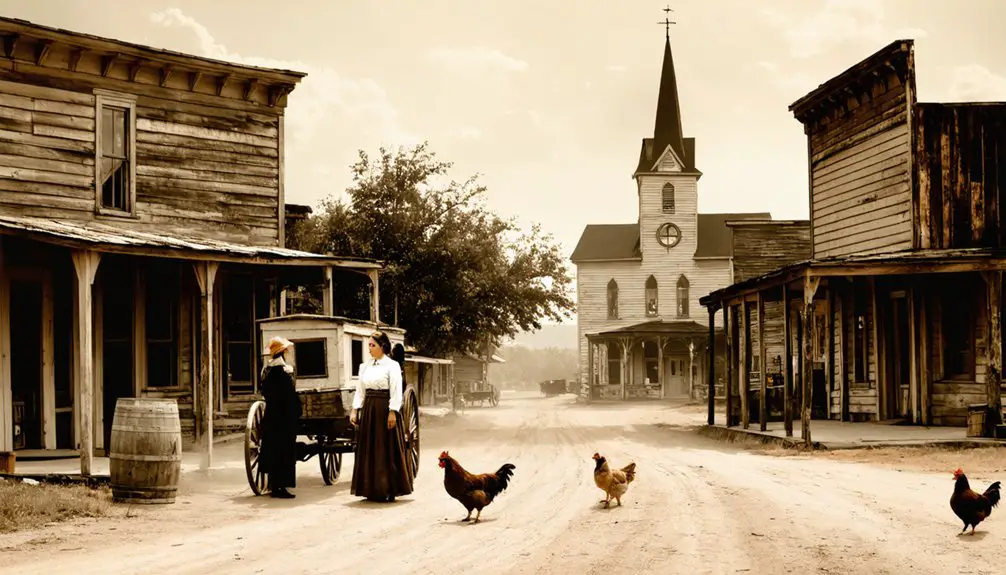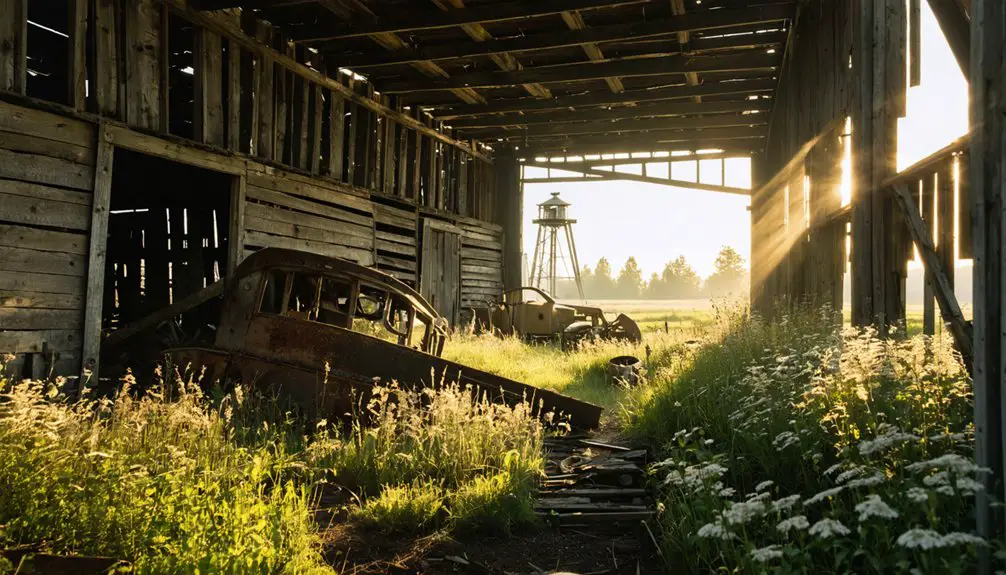You’ll discover Havilah’s story began in 1864 when gold was found along Clear Creek, sparking a rush that transformed open rangeland into a bustling trade center with 147 businesses by 1865. The settlement became home to a tight-knit German Lutheran community, with their 1905 church serving as the heart of local life. While mining declined by the 1920s, Havilah’s preserved structures, including its historic church and 1906 parsonage, still whisper tales of frontier dreams.
Key Takeaways
- Havilah was established in 1864 after gold discoveries along Clear Creek, becoming a bustling trade center with 147 buildings by 1865.
- The settlement transformed from a mining boomtown into a German Lutheran farming community after 1900, with a church built in 1905.
- Economic decline occurred when mining yields diminished and operating costs increased, causing families to leave by the 1920s.
- Few original structures remain today, with only stone foundations, a cemetery, church, flour mill schoolhouse, and 1906 parsonage still visible.
- Unlike other preserved ghost towns, Havilah’s timber-frame buildings have largely deteriorated, though preservation efforts continue through documentation and tourism.
The Birth of a Mining Settlement
When gold was discovered along Clear Creek in the spring of 1864, a small group of miners couldn’t keep their rich quartz deposit find secret for long.
Prospectors soon flooded the district, drawn by the promise of untapped wealth through quartz extraction and other mining techniques. You’ll find the settlement was named “Havilah” by Asbury Harpending, choosing the biblical reference meaning “land of gold” to reflect the area’s abundance. Much like James Henry Holden’s copper discovery in 1896, the find sparked significant interest despite geographic challenges.
The biblical name Havilah reflected the untold riches early miners discovered, as fortune seekers rushed to extract gold from quartz-laden hills.
As part of Tulare County at the time, this mountainous region between Kern River and Walker Basin quickly transformed into a bustling trade center. By 1865, the settlement had grown to include 147 business buildings throughout the town.
The boomtown attracted a diverse mix of adventurers, gamblers, and opportunists seeking their fortune on the frontier. Havilah‘s economic foundation rested firmly on the gold-rich mountains that surrounded it.
Early Pioneer Life and Community Building
After the North Half of the Colville Reservation opened to homesteaders in 1900, Havillah’s landscape transformed into a vibrant German Lutheran farming community. The settlement dynamics quickly took shape as pioneers like Martin Schweikert arrived in 1904, establishing vital enterprises that would sustain the growing population. Similar to the blockhouse forts of early Washington Territory, the settlers built sturdy structures for protection and community gathering.
Despite the pioneer challenges of geographic isolation, these determined settlers built their community from the ground up:
- A rough lumber church constructed in 1905 became their spiritual and social hub.
- A four-room parsonage completed by 1906 demonstrated their commitment to permanence.
- The gristmill and flour mill provided essential services for local food production.
You’ll find their legacy preserved in the restored schoolhouse and church, proof of a community that thrived through self-reliance and mutual support in the foothills north of Bonaparte Mountain. The community’s postal services remained active until mail was redirected to Tonasket in 1944.
Religious Foundations and Social Structure
Though Havillah’s earliest settlers were Methodists, the town’s religious identity shifted dramatically as German Lutheran farmers arrived in the early 1900s. These religious shifts transformed Havillah into a tight-knit farming community centered around their Lutheran faith.
In 1905, settlers built their first church using rough lumber, and by 1906, they’d added a two-story parsonage. Similar to volunteer-staffed museums in nearby towns like Oroville, the church became a cornerstone of local heritage. Much like the Cluedo church of 1858, they used hand-forged nails in the construction.
You’ll find that the Lutheran church became more than just a place of worship – it was the heart of community cohesion. The building served multiple purposes, functioning as a school, meeting hall, and social center.
The Lutheran church stood as Havillah’s vital hub, where worship, education, and community life seamlessly merged under one roof.
Church events structured daily life, while the congregation worked together on farms and gathered for community decisions. This cooperative spirit, rooted in shared religious values, helped Havillah’s pioneers survive and thrive in the frontier setting.
Gold Rush Era Impact and Development
During the region’s gold rush, you’ll find that early prospectors began staking claims around Havillah in 1896, quickly transforming the area from open rangeland into a bustling mining settlement.
You can trace the town’s rapid economic growth through the establishment of several mines, a post office, and various businesses that served the influx of fortune seekers between 1897 and 1900.
The discovery sparked a mining frenzy that brought approximately 1,500 prospectors to Okanogan County, dramatically changing the landscape and local demographics.
Much like the California town of Havilah, the settlement featured dance halls and saloons that provided entertainment for the hard-working miners.
Mining Claims and Settlement
When the Colville Indian Reservation opened for mineral entry in 1896, prospectors quickly flooded the Havillah region to establish mining claims focused on gold and silver deposits.
You’d find miners using various mining techniques from basic panning to more advanced tunneling, while legal disputes and claim jumping became common as competition intensified. Many prospectors relied on mining district descriptions to guide their search for promising claims.
The rush to stake claims transformed the area into a bustling settlement with three key developments:
- Construction of essential infrastructure including housing and general stores
- Establishment of schools and churches as families joined the mining community
- Formation of diverse ethnic communities, including Chinese placer miners
As claims matured, the settlement grew to support both mining operations and the families who’d made Havillah their home, though their fortunes remained closely tied to the success of mineral extraction. Several mining operations in the area, like the prominent Bi-Metallic mine, yielded significant deposits of silver, gold, and copper that helped sustain the local economy.
Economic Growth and Decline
As gold discoveries near Havillah sparked intense interest in the late 19th century, the once-quiet area transformed into a thriving economic hub. Gold speculation drew waves of prospectors, merchants, and settlers who rapidly established businesses, housing, and essential services.
You’d have found bustling shops selling mining equipment, food, and clothing, while timber operations expanded to meet construction demands.
The town’s economic resilience was tested as mining yields eventually diminished. When gold deposits were depleted, Havillah’s prosperity quickly unraveled. Businesses shuttered, workers departed, and infrastructure fell into disuse.
Despite attempts to diversify into agriculture and logging, the harsh terrain and limited market access proved challenging. While larger Washington cities successfully capitalized on regional gold rush trade, Havillah ultimately succumbed to the boom-and-bust cycle, fading into a ghost town.
Daily Life in Early 20th Century Havillah

In Havillah’s early days, you’d find the Lutheran church serving as the heart of community life, where families gathered regularly for worship and social events in a building constructed of locally sourced rough lumber.
If you’d visited in the early 1900s, you’d have witnessed a tight-knit farming community where daily schedules revolved around agricultural duties, milling operations, and frequent church activities.
Your experience of the settlement would have revealed a self-reliant population that maintained strong cultural ties through religious gatherings and community events, despite the limited amenities typical of rural Washington settlements of that era.
Church and Community Gatherings
Through the construction of Havillah’s first rough lumber church in 1905, settlers established an essential hub that would shape their community’s spiritual and social life for decades to come.
The church activities fostered a strong community identity, bringing together Methodist and German Lutheran settlers for shared experiences and celebrations.
Key elements that defined the church’s central role:
- A four-room parsonage completed by 1906 provided a permanent home for clergy leadership.
- The church building served multiple functions, hosting weddings, funerals, education, and community meetings.
- Seasonal gatherings and holiday events centered around the church grounds strengthened social bonds.
You’ll find the church bell and building still standing today, preserved as cultural landmarks that tell the story of Havillah’s pioneering spirit.
Mining Camp Living Conditions
The stark realities of mining camp life stood in sharp contrast to the community gatherings at Havillah’s church.
You’d find yourself living in cramped quarters, typically small wooden cabins or tents, where protection from harsh mountain weather was minimal. Basic outhouses served as your only sanitary facilities, positioned away from living spaces.
Daily survival meant adapting to communal cooking arrangements, where you’d rely heavily on preserved foods like salted meats, beans, and hardtack. Fresh produce was a rare luxury, given the camp’s isolation.
You’d spend long hours performing backbreaking work in dangerous conditions, often operating in shifts around the clock. To cope with the harsh lifestyle, you’d find comfort in the camp’s social spaces – bars and makeshift gathering spots where miners shared stories, gambled, and found brief respite from their demanding existence.
Architecture and Infrastructure Remnants
Today’s visitors to Havillah will find scant evidence of the once-bustling frontier settlement, as nature has steadily reclaimed most original structures over decades of abandonment.
The architectural decay reveals the town’s historical significance through scattered foundation stones and deteriorating wooden remnants, painting a picture of a loosely organized frontier community.
You’ll discover three key features that define Havillah’s remaining infrastructure:
- Rectangular stone foundations marking former homes and businesses, now mostly obscured by vegetation
- Simple timber-frame construction techniques using locally sourced materials
- Small cemetery sites with weathered markers offering glimpses into the community’s past
Unlike more preserved ghost towns such as Nighthawk, Havillah lacks surviving commercial buildings or industrial remnants, with most structures now roofless or completely collapsed.
The Decline of a Frontier Dream

You’ll find that Havillah’s frontier dreams dimmed in the early 20th century as declining metal values and rising operating costs made local mining operations unsustainable.
By the 1920s, the once-bustling streets fell silent as families departed for better opportunities, leaving behind abandoned storefronts and empty homes that stood as evidence to the community’s golden era.
While the physical town has faded into history, the legacy of Havillah’s pioneering spirit lives on through preserved stories and photographs of the close-knit mining community that once called this remote Washington settlement home.
Mining Dreams Fade Away
While initial gold discoveries near Havillah in 1859 sparked dreams of lasting wealth, these aspirations quickly encountered harsh realities that would ultimately spell doom for the frontier mining town.
The early mining optimism couldn’t overcome mounting economic challenges, as operations struggled against nature and market forces.
You’d have witnessed these critical setbacks:
- Complex infrastructure like cable tramways and gravity mills required massive investment, yet remained vulnerable to devastating snowslides.
- Limited water supplies and seasonal constraints restricted continuous mining operations.
- Low-value ore concentrates yielded diminishing returns while labor costs remained high.
As rumors of richer strikes drew miners elsewhere and gold prices fluctuated, Havillah’s dream of sustained prosperity slipped away.
Many claims were abandoned, and miners eventually traded their gold fever for more reliable pursuits elsewhere.
Empty Streets Remain Silent
The once-bustling streets of Havillah now echo with an eerie stillness, marking the final chapter of this frontier settlement’s decline. Urban exploration reveals the remnants of a community that gradually faded away after its early 1900s peak, when German Lutheran farmers built their dreams here.
You’ll find the 1905 post office closed since 1944, with mail services redirected to Tonasket. The town’s heartbeat – its flour mill, schoolhouse, church, and parsonage – stand as silent sentinels to historical preservation efforts rather than serving their original purposes.
While these structures remain intact, they’re now mere shadows of their former liveliness. Nature steadily reclaims unpaved roads and empty lots, while remaining buildings face the slow decay that comes with minimal maintenance and diminished population.
Lost Community Lives On
Despite initial optimism among German Lutheran settlers, Havillah’s decline began as a perfect storm of economic and transportation changes swept through the region in the early 1900s.
Today, you’ll find lost connections to this frontier dream preserved in local histories and fading memories, while cemeteries stand as silent witnesses to a once-thriving community.
The town’s legacy lives on through:
- Heritage tourism that draws history enthusiasts seeking to explore the remnants of frontier life
- Preserved historical records documenting the community’s rise and fall through changing economic landscapes
- Local lore passed down through generations, keeping the spirit of early settlers alive
While Havillah’s streets may be quiet now, its story continues to resonate as a reflection of the challenges and resilience of frontier settlements.
Notable Characters and Local Legends

Among Havillah’s most influential pioneers stands Martin Schweikert, who arrived in 1904 and quickly established himself as a cornerstone of the community.
You’ll find his legacy in the gristmill he founded, which later expanded into a flour mill and store that became crucial to the town’s survival.
While other legendary settlers helped shape Havillah’s character, transforming it from a Methodist outpost to a thriving German Lutheran farming community, Schweikert’s entrepreneurial spirit left an indelible mark.
Today, ghostly tales surround the abandoned structures he built, especially the mill that once served as the economic heart of this rural settlement.
Local lore intertwines with historical accounts of homesteader hardships, adding to the mystique of this Okanogan County ghost town that never quite experienced the gold rush boom of its neighbors.
Preserving Havillah’s Historical Legacy
While ghostly tales and pioneer legends paint a vivid picture of Havillah’s past, dedicated preservation efforts now protect its physical remnants for future generations.
You’ll find remarkable examples of historical significance in the restored church, flour mill schoolhouse, and 1906 two-story parsonage – all evidence of early settler ingenuity.
Local preservation groups tackle three main challenges:
- Maintaining authentic rough lumber structures against natural deterioration
- Documenting settlement history through photographs, maps, and oral histories
- Protecting sites from unauthorized alterations while preserving cultural heritage
You can explore this living history through community events that showcase farming traditions and homesteading practices.
The Washington State Historic Preservation Plan guarantees these treasures remain protected, though preservation challenges continue as resources remain limited.
Ghost Town Tourism and Modern Interest
As ghost town tourism gains momentum across America, Havillah has emerged as a fascinating destination for history enthusiasts and adventure seekers.
You’ll find modern tourism adapting to meet growing interest through virtual reality tours, drone photography, and interactive digital maps that help you explore the site safely while preserving its authenticity.
The ghost town’s appeal extends beyond physical visits, as social media platforms showcase its haunting beauty and rich history.
Social media has transformed Havillah’s ghostly presence, letting visitors share its mysterious allure with audiences worldwide.
You can now engage with Havillah’s past through online archives, historical databases, and educational programs focusing on its cultural significance.
Local economies have responded to this surge in interest by developing tourism infrastructure, though they’re careful to balance preservation with accessibility.
Whether you’re a photographer, historian, or urban explorer, Havillah offers a unique window into Washington’s pioneering past.
Frequently Asked Questions
Are There Any Paranormal Activities Reported in Havillah’s Remaining Structures?
You’ll find reports of ghost sightings near abandoned structures, with visitors describing whispers and cold spots. Local explorers share stories of haunted buildings where they’ve experienced unexplained touches and shadowy figures.
What Happened to the Original Church Artifacts and Religious Items?
You’ll find no clear record of the church relics’ fate – they likely scattered after 1944 when services ended, though some items may remain with settler families or neighboring communities of historical significance.
Can Visitors Legally Explore and Metal Detect in Havillah Today?
You’ll need permission since most land is private. Metal detecting regulations require landowner consent, and visitor guidelines suggest consulting county officials before exploring or detecting in the area.
Were There Any Major Crimes or Notable Shootouts in Havillah?
You won’t find any major crimes or notable shootouts in the town’s crime history. Unlike nearby boomtowns, this peaceful farming community’s notable incidents centered on church life and agriculture.
Did Native Americans Have Settlements at the Havillah Site Before Miners Arrived?
While Native settlements existed throughout the region, you won’t find direct historical evidence of specific villages at that exact site before miners arrived in the late 1800s, though tribes used the area.
References
- https://okanogancountry.com/ghost-towns
- http://www.ghosttownsusa.com/havillah.htm
- http://www.ghosttownsusa.com/okanco.htm
- https://en.wikipedia.org/wiki/Molson
- https://www.tiktok.com/@crimewithkourt/video/6877559418511232261
- https://www.thegoodlifesv.com/story/2019/09/01/history/the-short-and-exciting-life-of-havilah-land-of-gold/446.html
- https://www.dnr.wa.gov/Publications/ger_misc_holden_tailings.pdf
- https://www.holdenvillage.org/about/history/
- https://www.wenatcheevalleymuseum.org/2024/chinese-mined-around-wenatchee-5-24-2024/
- https://mabel.wwu.edu/do/19159/iiif/053d3c5a-a14b-45bb-a85d-d00ee157d22e/full/full/0/cpnws_ops_004_Indian-and-Pioneer-Settlement-in-the-Nooksack-Lowland-to-1890-.11190.pdf



